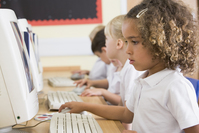Some DC schools are betting that personalization can fix education

Photo from Bigstock.
DC is at the forefront of a movement to make education a more personalized experience, relying in part on technology to tailor learning to each student’s needs and interests. The approach promises to ensure that advanced students are challenged and struggling ones engaged, even if they share the same classroom.
In any given classroom, some kids grasp the material easily while others need more help. Teachers have generally taught to the middle, with the inevitable result that some kids are bored and some are lost.
While experts have long advised teachers to differentiate instruction so they can reach each student at her level, that takes a lot of training and talent. Some say it’s impossible.
Now a different, more personalized approach is gaining ground across the country and in the District. While personalized learning models vary, most rely at least partly on technology to allow students to progress at their own pace, moving on when they’ve demonstrated mastery—sometimes of content they’ve chosen for themselves.
Programs that blend traditional and technology-based instruction are now in place at 17 schools within the DC Public School system on a school-wide basis. Many others use the approach in at least some of their classrooms.
And DC’s CityBridge Foundation, through an initiative called Breakthrough Schools: DC, has provided funding and technical support to help 13 DC schools devise new personalized learning models. Each school can receive as much as $500,000 over the course of several years.
Evidence on the effectiveness of personalized learning has been scant, and the term embraces so many different models that it’s hard to evaluate its success overall. Last year, however, two studies found that some low-income schools using personalized models had positive outcomes on test scores and other measures.
Some personalized and blended learning models could have drawbacks
Personalized and blended learning models have the potential to engage all students without separating them into different tracks, as schools used to do. But there are reasons to proceed with caution.
If kids are allowed to progress at their own pace, many may opt not to challenge themselves. If they’re also allowed to choose what to learn, some may not choose wisely. And if each student is studying something different, it’s hard to have a group discussion or an exchange of ideas.
And under many blended learning models, including those used at some DCPS schools, kids spend the day rotating between stations in a single classroom, spending a third of their time working at computers.
Students in those classrooms can lose valuable instructional time while making transitions. And in the many classrooms that have only one teacher, the unsupervised students working at computers don’t always stay on task.
Even if they do, much of the software currently available has no connection to what students are learning from their teachers. Students may spend hours every week practicing reading comprehension skills rather than acquiring knowledge, an approach that is particularly harmful for low-income students.
Older methods of personalization are worth trying too
Given those possible flaws, we shouldn’t lose sight of old-fashioned, low-tech ways of personalizing learning. One would be to have students write about what they’re studying, something schools don’t often do these days. Struggling students could write a sentence, more advanced ones a paragraph, and others an entire essay.
And then there’s the time-honored version of personalization employed by the wealthy: tutoring.
There are logistical barriers to bringing both of these methods of personalization to schools on a large scale, but they’re not insurmountable. DCPS has been piloting a writing program that has had encouraging results with students of varying needs and abilities.
And while tutoring has historically been expensive, at least one school has pioneered a low-cost version that has boosted achievement dramatically.
Like tutors, computers can get students to practice skills and give them immediate feedback. But they can’t provide the emotional connection that is important in stimulating learning . Nor can they teach students to write well, or possibly to develop the analytical skills that good writing requires.
Of course, the high-tech and low-tech approaches don’t have to be mutually exclusive. Used thoughtfully, computers can free up teachers’ time to work with students one-on-one or in small groups, building relationships and doing other things only humans can do.
And personalization, if balanced by whole-group activities that create dialogue and a sense of community, is a more realistic approach than assuming that all students are proceeding in lockstep just because they happen to be the same age.
So by all means, let’s experiment, judiciously, with these new approaches to an old problem. But at the same time, let’s try to find ways to use older pathways to personalization that are tried and true.
 An expanded version of this post is available at DC Eduphile.
An expanded version of this post is available at DC Eduphile.
